Milky Way
Appearance
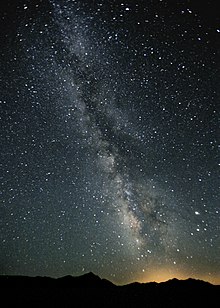
Milky Way is the galaxy that contains our Solar System. Its name “milky” is derived from its appearance as a dim glowing band arching across the night sky in which the naked eye cannot distinguish individual stars. The term “Milky Way” is a translation of the Latin via lactea, from the Greek γαλαξίας κύκλος (galaxías kýklos, "milky circle"). From Earth, the Milky Way appears as a band because its disk-shaped structure is viewed from within. Galileo Galilei first resolved the band of light into individual stars with his telescope in 1610.
Quotes
[edit]- Quotes are arranged alphabetically by author
A - F
[edit]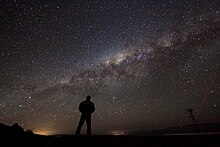



We cast this message into the cosmos. It is likely to survive a billion years into our future, when our civilization is profoundly altered and the surface of the Earth may be vastly changed. Of the 200 billion stars in the Milky Way galaxy, - Jimmy Carter
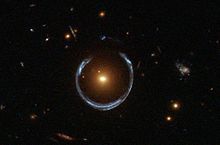

- As, pricked out with less and greater lights, between the poles of the universe, the Milky Way so gleameth white as to set very sages questioning.
- Dante Alighieri in "Paradise" quoted in: Sir Arthur Stanley Eddington The Expanding Universe: Astronomy's 'Great Debate', 1900-1931, Cambridge University Press, 1933, p. 1
- For the Milky Way, we find that the orbital speed increases and then remains roughly constant. This implies that we are still within the body of the Milky Way, even at the largest distances from the center of the Milky Way. We have not yet located the edge of the Milky Way; the Milky Way extends much further than the edge of the disk of stars (the visible disk)! The mass contained in the Milky Way (in the visible disk) is 2x1011 M(Sun). The mass contained in the Milky Way galaxy (out to as far as we can see HI gas) is 6x1011 M(Sun).
- Archive in: Mass of the Milky Way Galaxy, University of Oregon
- ...the mass where we can see stars is only 1/3 of the mass of the entire Galaxy. This suggests that a lot of mass in the Milky Way is in some form which does not radiate large amounts of light (Dark Matter).
- Archive in: "Mass of the Milky Way Galaxy"
- "Sjelfva vintergatan är idel verldar, hvilkas sken som knappast räcker til oss."
- "The Milky Way itself is wholly worlds, the glow of which is hardly enough for us".
- By Anonymous in "Variarum rerum vocabula cum Sueca interpretatione" (1579), quoted in: SAOB (2017)
- First attestation of Vintergatan (The Milky Way) in the Swedish language.
- Fascinated by its symmetry the geometer may at times have been too exclusively engrossed with his science, forgetful of its applications; he may have exalted it into his idol and worshipped it; he may have degraded it into the toy– when he should have been hard at work with it, using it mankind and the glory of his creator....But ascend with me above the dust, above the cloud, to the realms of the higher geometry, where the heavens are never clouded, where there is no impure vapour and no delusive or imperfect observation, where the new truths are already arisen, while they are yet dimly dawning on the world below, where the earth is a little planet; where the sun has dwindled to a star; where all the stars are lost in the Milky Way to which they belong ; where the Milky Way is seen floating through space, like any other nebula; where the whole great girdle of the nebulae has diminished to an atom and has become as readily and completely submissive to the pen of geometer, and the slave of his formula, as the single drop, which falls from the clouds instinct with all forces of the material world. Try with me the precision of measure with which the universe has been meted out; observe how exactly all the parts are fitted to the whole and to each other, and then declare who was present in the council-chamber when the Lord laid the foundations of the earth.
- Professor Benjamin Bierce in: Proceedings of the American Association for the Advancement of Science, American Association for the Advancement of Science, 1855, p. 2
- It may seem rash indeed to draw conclusions valid for the whole universe from what we can see from the small corner to which we are confined. Who knows that the whole visible universe is not like a drop of water at the surface of the earth? Inhabitants of that drop of water, as small relative to it as we are relative to the Milky Way, could not possibly imagine that beside the drop of water there might be a piece of iron or a living tissue, in which the properties of matter are entirely different.
- Émile Borel in: Space and Time, Courier Dover Publications, 2003, p. 227
- Astronomers have mapped the cosmic watershed in which our Milky Way Galaxy is a droplet. The massive structure, which the research team dubs the Laniakea Supercluster, extends more than 500 million light-years and contains 100,000 large galaxies.
The work, published in the September 4th Nature, is the first to trace our local supercluster on such a large scale. It also provides a physical way to define what a supercluster actually is.- Camille M. Carlisle in: "Laniakea: Our Home Supercluster" at Sky and Telescoe", skyandtelescope.com, 3 September 2014
- We cast the message to the cosmos. It is likely to survive a billion years into our future. When our civilization is profoundly altered and the surface of the Earth may be vastly changed. Of the 200 billion stars in the Milky Way galaxy, some — perhaps many — may have inhabited planets and space faring.
- Jimmy Carter in: Barry Vacker Crashing Into the Vanishing Points, Theory Vortex Experiments, 2009, p. 13
- This Voyager spacecraft was constructed by the United States of America. We are a community of 240 million human beings among the more than 4 billion who inhabit the planet Earth. We human beings are still divided into nation states, but these states are rapidly becoming a single global civilization.
We cast this message into the cosmos. It is likely to survive a billion years into our future, when our civilization is profoundly altered and the surface of the Earth may be vastly changed. Of the 200 billion stars in the Milky Way galaxy, some--perhaps many--may have inhabited planets and space faring civilizations. If one such civilization intercepts Voyager and can understand these recorded contents, here is our message:
"This is a present from a small distant world, a token of our sounds, our science, our images, our music, our thoughts, and our feelings. We are attempting to survive our time so we may live into yours. We hope someday, having solved the problems we face, to join a community of galactic civilizations. This record represents our hope and our determination, and our good will in a vast and awesome universe”.- Jimmy Carter, in his statement as President of the United States on 29 July 1977 quoted in : Public Papers of the Presidents of the United States: Jimmy Carter, 1977, Best Books on, 1 January 1977, p. 1379
- Most known extrasolar planets (exoplanets) have been discovered using the radial velocity, or transit methods. Both are biased towards planets that are relatively close to their parent stars, and studies find that around 17–30% of solar-like stars host a planet. Gravitational microlensing, on the other hand, probes planets that are further away from their stars. Recently, a population of planets that are unbound or very far from their stars was discovered by microlensing. These planets are at least as numerous as the stars in the Milky Way.
- A. Cassan, et al., in: One or more bound planets per Milky Way star from microlensing observations, Nature, International Journal of Science
- It was first surmised by the ancient philosopher, Democritus, that the faintly white zone which spans the sky under the name of the Milky Way, might be only a dense collection of stars too remote to be distinguished. This conjecture has been verified by the instruments of modern astronomers, and some speculation of a remarkable kind have been formed in connection with it.
- Robert Chambers in: Vestiges of the natural history of creation, J. Churchill, 1847, p. 3
- Actual proof of the Milky Way consisting of many stars came in 1610 when Galileo Galilei used a telescope to study the Milky Way and discovered that it was composed of a huge number of faint stars.
- I can never look now at the Milky Way without wondering from which of those banked clouds of stars the emissaries are coming. If you will pardon so commonplace a simile, we have set off the fire alarm and have nothing to do but to wait.
I do not think we will have to wait for long.- Arthur C. Clarke, in The Sentinel (1948), originally titled "Sentinel of Eternity" this is the short story which later provided the fundamental ideas for 2001: A Space Odyssey (1968) written by Clarke and Stanley Kubrick.
- Galileo claimed to have seen mountains on the Moon, to have proved the Milky Way was made up of tiny stars, and to have seen four small bodies orbiting Jupiter. These last, with an eye to getting a position in Florence, he quickly named 'the Medicean stars'.
- J J O'Connor and E F Robertson in: Galileo Galilei,
- The astronomical discoveries he [Galileo] made with his telescopes were described in a short book called the "Starry Messenger" published in Venice in May 1610. This work caused a sensation.
G - L
[edit]

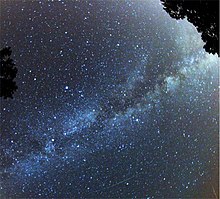
When the sun shall die, the planet will freeze, and
The air on them; frozen gases, white flakes of air
Will be the dust: which no wind ever will stir; this very dust in dim starlight glistening... - Robinson Jeffers

- What was observed by us in the third place is the nature or matter of the Milky Way itself, which, with the aid of the spyglass, may be observed so well that all the disputes that for so many generations have vexed philosophers are destroyed by visible certainty, and we are liberated from wordy arguments.
- Galileo Galilei in: Sidereus Nuncius, Or The Sidereal Messenger, University of Chicago Press, Apr 15, 1989, p. 62
- Space is not space between the earth and the sun to one who looks down from the windows of the Milky Way.
- Kahlil Gibran in “Sand and Foam” quoted in: C.C. Gaither “Astronomically Speaking: A Dictionary of Quotations on Astronomy and Physics”, p. 325
- Scientists previously placed the Milky Way in the Virgo Supercluster, but under Tully and colleagues' definition, this region becomes just an appendage of the much larger Laniakea, which is 160 million parsecs (520 million light years) across and contains the mass of 100 million billion Suns.
- Elizabeth Gibney in: "Earth's new address: 'Solar System, Milky Way, Laniakea', nature, 3 September 2014
- What of the scientists who assumed that continents were stable, that the hereditary material was protein, or that all other galaxies lay within the Milky Way? These false and abandoned efforts were pursued with passion by brilliant and honoura le scientists.
- Stephen Jay Gould in: Eight Little Piggies: Reflections in Natural History, W. W. Norton & Company, Nov 29, 2010
- Exalted Manna, gladness of the best,
Heaven in ordinary, man well dressed,
The milky way, the bird of Paradise,
Church bells beyond the stars heard, the soul's blood,
The land of spices something understood.- George Herbert in: Joseph Black, et al., The Broadview Anthology of British Literature, second edition: Concise Edition, Volume 1, Broadview Press, 8 September 2011, p. 870
- As we are used (says he) to call the appearance of the heavens, where it is surrounded with a bright zone, the milky-way, it may not be amiss to point out some other very remarkable nebulae, which cannot well be less, but are probably much larger, than our own system ; and being extended, the inhabitants of the planets that attend the stars which compose them, must likewise perceive the same phenomenon; for which reason that may also be called milky-ways, by way of distinction.
- William Herschel in: Encyclopaedia Britannica: Or, A Dictionary of Arts, Sciences, and Miscellaneous Literature, Enlarged and Improved, Volume 3, Archibald Constable, 1823, p. 79
- The Milky Way is a most extensive stratum of stars of various sizes admits no longer of the least doubt and our sun is actually one of the heavenly bodies belonging to it as evident. I have now viewed this shining zone in almost every direction, and find it composed of stars, whose number, by the account of these gages, constantly increases and decreases in proportion to its apparent brightness to the naked eye.
- William Herchel in: Philosophical Transactions of the Royal Society of London: Giving ..., Volume 75, Royal Society (London), 1785, p. 213
- We may also draw a very important additional conclusion from the gradual dissolution of the Milky Way; for the state into which the incessant action of the clustering power [presumably, gravity] has brought it at present, is a kind of chronometer that may be used to measure the time of its past and future existence; and although we do not know the rate of going of this mysterious chronometer, it is nevertheless certain, that since the breaking up of the parts of the milky way affords a proof that it cannot last for ever, it equally bears witness that its past duration cannot be admitted to the infinite.
- Sir William Herschel in: Chambers's Papers for the People, Volumes 3-4, Lippincott, 1856, p. 29
- The cosmos is extremely complex....Earth is nothing but a speck of dust, and it is insignificant. Yet within this there are innumerable and complex structures. What are these structures of dimensions like?...Which level of dimension does our humankind live-in ? We live in the surface matter comprised of the biggest layer of molecular particles; we live in between molecules and planets—a planet is also a particle, and within the vast cosmos, it, too, is a trivial speck of dust. The Milky Way Galaxy is also a trivial speck of dust. This universe—the small universe I just described—is also but a trivial speck of dust. The largest particles that our human see are the planets, and the smallest particles visible to humankind are molecules. We humans exist in between the particles of molecules and planets. Being in this dimension, you think it is vast; from a different perspective, it is actually extremely narrow and tiny.
- Li Honghzi in: Falun Gong and the Future of China, Oxford University Press, 16 Apr il 2008, p. 99
- The nebula is another stellar disc, composed of billions of suns, and constituting the Milky Way of some unknown firmament. Herschel has counted more than two thousand nebulae. Our Milky Way is the dwelling; the nebulae are the city.
- Victor Hugo in: Victor Hugo's Intellectual Autobiography, Funk & Wagnalls, 1907, p. 243
- Time will come no doubt,
When the sun shall die, the planet will freeze, and
The air on them; frozen gases, white flakes of air
Will be the dust: which no wind ever will stir; this very dust in dim starlight glistening
Is dead wind, the white corpse of wind.
Also, the galaxy will die; the glitter of the Milky Way, our universe, all the stars that have names are dead.
Vast is the night. How you have grown, dear night,
Walking your empty halls, how tall!- Robinson Jeffers in “The Double Axe Part II of the Double Axe The Inhumanist Stanza 11 (p.58) quoted in: C.C. Gaither “Astronomically Speaking: A Dictionary of Quotations on Astronomy and Physics”, p. 413
- ...the old man looked up
At a black eyelet in the white of the Milky Way, and he thought with wonder: "There — or thereabout — Cloaked in thick darkness in his power's dust-cloud, There is the hub and heavy nucleus, the ringmaster.
Of all this million-shining whirlwind of dancers, the stars of this end of heaven, it is strange, truly,
That great and small, the atoms of grain of sand and the suns of planets, and all the galactic universes.
Are organized on one pattern, the eternal roundabout, the heavy nucleus and whirling electrons the leashed,
And panting runners going nowhere; frustrated flight, unrelieved of strain endless return –
all-
-all.- Robinson Jefferson, in “The Double Axe and Other Poems” Part II of The Double Axe The Inhumanist Stanza 22 (p.67) quoted in: C.C. Gaither “Astronomically Speaking: A Dictionary of Quotations on Astronomy and Physics”, p. 238
- If you want to see a black hole tonight, tonight just look in the direction of Sagittarius, the constellation. That's the center of the Milky Way Galaxy and there's a raging black hole at the very center of that constellation that holds the galaxy together.
- Michio Kaku in: Michio Kaku interview by Deepak Chopra, beliefnet.com
- We come no nearer the infinitude of the creative power of God, if we enclose the space of its revelation within a sphere described with the radius of the Milky Way, than if we were to limit it to a ball an inch in diameter. All that is finite, whatever has limits and a definite relation to unity, is equally far removed from the infinite... Eternity is not sufficient to embrace the manifestations of the Supreme Being, if it is not combined with the infinitude of space.
- The stars are words and all the innumerable worlds in the Milky Way are words, and so is this world too. And I realize that no matter where I am, whether in a little room full of thought, or in this endless universe of stars and mountains, it’s all in my mind.
- Jack Kerouac in: Lonesome Traveler, Grove Press, 1960, p. 131
- God be thanked for the Milky Way that runs across the sky,
That's the path that my feet would tread whenever I have to die.
Some folks call it a Silver Sword, and some a Pearly Crown,
But the only thing I think it is, is Main Street, Heaventown.- Joyce Kilmer in: The Methodist Review, Volume 102, Methodist book concern, 1919, p. 314
- Now, almost one hundred years later [in 1916 when Einstein began to apply his theory to describe the universe as a whole], it is difficult to fully appreciate how much our picture of the universe has changed in the span of a single human lifetime. As far as the scientific community in 1917 was concerned, the universe was static and eternal, and consisted of a one single galaxy, our Milky Way, surrounded by vast, infinite, dark, and empty space This is, after all, what you would guess by looking up at the night sky with your eyes, or with a small telescope, and at the time there was little reason to suspect otherwise.
- Lawrence M. Krauss in: A Universe from Nothing: Why There Is Something Rather than Nothing, Simon and Schuster, 10 January 2012, p. 27
M - R
[edit]- A broad and ample road, whose dust is gold,
And pavement stars—as starts to thee appear
Soon in the galaxy, that Milky Way
Which mightily as a circling zone thou seest
Powder'd with stars.- John Milton in: The Poetical Works of John Milton, W. Baxter, 1824, p. 51
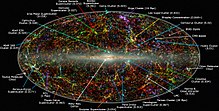
- This week, scientists add a new line to our planetary coordinates: the Laniakea galaxy supercluster.
Do not bother googling the name. It really is brand new, coined by an international group of astronomers… Our place in the Universe, for so long one of the core mysteries of human existence that scientists and this journal are dedicated to unravelling, just got a little clearer. Laniakea, the scientists write, is our home supercluster, the one in which the Milky Way resides.
What kind of home is it? It is big — some 160 million parsecs across. Although not as big as some superclusters, it is the largest in our local neighbourhood, which is surprisingly crowded given the vast emptiness of most of the cosmological void. It is a home that has been hiding in plain sight, colossal and all around us, yet unnoticed by previous astronomical surveys. ...The name Laniakea has Hawaiian roots, and roughly translated means spacious heaven. It is a beautiful address to have. And one that comes just in time for the new school year and a new curious generation.- Nature editorial: "Heavenly homes",nature.com, 3 September 2014
- Consider now the Milky Way. Here also we see an innumerable dust, only the grains of this dust are no longer atoms but stars; these grains also move with great velocities, they act at a distance one upon another, but this action is so slight at great distances that their trajectories are rectilinear; nevertheless, from time to time, two of them may come near enough together to be deviated from their course, like a comet that passed too close to Jupiter. In a word, in the eyes of a giant, to whom our Suns were what our atoms are to us, the Milky Way would only look like a bubble of gas.
- Henri Poincaré in: Science and Method, Cosimo, Inc., 1 January 2010, p. 254
- Lo! the poor Indian! whose untutor’d mind
Sees God in clouds, or hears him in the wind;
His soul proud Science never taught to stray
Far as the solar walk or milky way.
Yet simple nature has given
Behind the cloud-topt hill, as humbler Heaven;- Alexander Pope in: John Aikin Select works of the British poets, in a chronological series from Ben Jonson to Beattie: with biographical and critical notices, T. Wardle, 1843, p. 362
- For the first time, astronomers have outlined and named the network of galaxies that includes the Milky Way, adding a line to our cosmic address and further defining our place in the universe. They call it Laniakea, which is Hawaiian for “immense heaven.”
- Douglas Quenqua, in "Giving the Milky Way a New Sense of Place", The New York Times, 3 September 2014

- The sun's location near the galactic plane gives rise to the appearance of the Milky Way in the sky. When one looks at the Milky Way one is looking at the plane of the disk where the stars are concentrated. The greatest concentration of stars is in the direction of the galactic center, in the constellation of Sagittarius. Consequently, it might be anticipated that the Milky Way would be brightest in this direction.
- William J. Redding In: The Twentieth century international encyclopedia, Publishers International Press, 1978, p. 1138
- The Milky Way was a familiar sight to all, snaking across the heavens with its light and dark patches forming recognizable shapes. The sky also contained numerous isolated faint and fuzzy objects (nebulae), fixed among the stars, as well as bright wandering stars (planets), and of course the moon, dominating the night sky, lighting the way by night and rendering many of its fainter companions temporarily invisible.
- Clive L. N. Ruggles in: Ancient Astronomy: An Encyclopedia of Cosmologies and Myth, ABC-CLIO, Jan 1, 2005 , p. 9
- In the visible world, the Milky Way is a tiny fragment; within this fragment, the solar system is an infinitesimal speck, and of this speck our planet is a microscopic dot. On this dot, tiny lumps of impure carbon and water, of complicated structure, with somewhat unusual physical and chemical properties crawl about for a few years, until they are dissolved again into the elements of which they are compounded.
- Bertrand Russell in: Uncertain Paths to Freedom: Russia and China, 1919-22, Psychology Press, 2000, p. 17

- The Sun is no lonelier than its neighbors; indeed, it is a very common-place star,—dwarfish, though not minute,—like hundreds, nay thousands, of others. By accident the brighter component of Alpha Centauri (which is double) is almost the Sun's twin in brightness, mass, and size. Could this Earth be transported to its vicinity by some supernatural power, and set revolving about it, at a little less than a hundred million miles' distance, the star would heat and light the world just as the Sun does, and life and civilization might go on with no radical change. The Milky Way would girdle the heavens as before; some of our familiar constellations, such as Orion, would be little changed, though others would be greatly altered by the shifting of the nearer stars. An unfamiliar brilliant star, between Cassiopeia and Perseus would be—the Sun. Looking back at it with our telescopes, we could photograph its spectrum, observe its motion among the stars, and convince ourselves that it was the same old Sun; but what had happened to the rest of our planetary system we would not know.
- Henry Norris Russell in: The Solar System and Its Origin, MacMillan, 1935, p. 2
S - Z
[edit]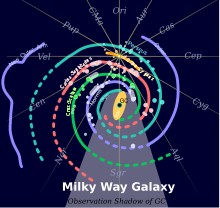
- But tell me, did you sail across the sun? Did you make it to the Milky Way? to see the lights all faded... And that Heaven is overrated? And tell me, did you fall for a shooting star? One without a permanent scar, and did you miss me While you were looking for yourself out there?
- Drops of Jupiter, Train (2001)
- We think it possible that the Milky Way Galaxy is teeming with civilizations as far beyond our level of advance as we are beyond the ants, and paying us about as much attention as we pay to the ants.
- Carl Sagan, William I. Newman in: Edward Regis Extraterrestrials: Science and Alien Intelligence, CUP Archive, 1987, p. 160
- The brain is waking and with it the mind is returning. It is as if the Milky Way entered upon some cosmic dance. Swiftly the head-mass becomes an enchanted loom where millions of flashing shuttles weave a dissolving pattern, always a meaningful pattern though never an abiding one; a shifting harmony of subpatterns.
- Sir Charles Scott Sherrington in: Graham Clarke Henry James: Critical Assessments, Volume 2, Psychology Press, 1991, p. 421
- The great topmost sheet of the mass, that where hardly a light had twinkled or moved, becomes now a sparkling field of rhythmic flashing points with trains of traveling sparks hurrying hither and thither. The brain is waking and with it the mind is returning. It is as if the Milky Way entered upon some cosmic dance. Swiftly the head mass becomes an enchanted loom where millions of flashing shuttles weave a dissolving pattern, always a meaningful pattern though never an abiding one; a shifting harmony of sub-patterns. Now as the waking body rouses, sub-patterns of this great harmony of activity stretch down into the unlit tracks of the stalk-piece of the scheme. Strings of flashing and travelling sparks engage the lengths of it. This means that the body is up and rises to meet its waking day.
- C.S. Sherrington in: Kathy Hall et al., Networks of Mind, Routledge, 13 December 2013, p. 34
- There is a point of view among astronomical researchers that is generally referred to as the Principle of Mediocrity. … If the Sun and its retinue of worlds is only one system among many, then many other systems will be like ours: home to life. Indeed, to the extent that this is true, we should be prepared for the possibility that, even in the Milky Way galaxy, billions of planets may be carpeted by the dirty, nasty business known as life.
- Seth Shostak in: “Do Aliens Exist in the Milky Way” in PBS, September 12: Space Travel, daysworld.org, 12 september 2014

- Astronomy had three great revolutions in the past four hundred years. The first was the Copernican revolution that removed the earth from the center of the solar system and placed it 150 million kilometers away from it; the second occurred between 1920 and 1930 when, as a result of the work of H. Shapley and R.J. Trumpler, we realized that the solar system is not at the center of the Milky Way but about 30,000 light years away from it, in a relatively dim spiral arm; the third is occurring now, and, whether we want it or not, we must take part in it. This is the revolution embodied in the question: Are we alone in the universe?
- Otto Struve in: C.C. Gaither : C.C. Gaither Astronomically Speaking: A Dictionary of Quotations on Astronomy and Physics, CRC Press, 1 August 2003, p. 27
- This whole earth which we inhabit is but a point in space. How far apart, think you, dwell the two most distant inhabitants of yonder star, the breadth of whose disk cannot be appreciated by our instruments? Why should I feel lonely? Is not our planet in the Milky Way?
- Henry David Thoreau in: C.C. Gaither “Astronomically Speaking: A Dictionary of Quotations on Astronomy and Physics”, p. 194
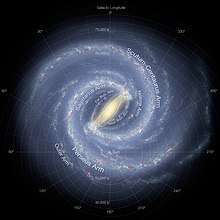
- A plain, reasonable working man supposes, in the old way which is also the common-sense way, that if there are people who spend their lives in study, whom he feeds and keeps while they think for him—then no doubt these men are engaged in studying things men need to know; and he expects of science that it will solve for him the questions on which his welfare, and that of all men, depends. He expects science to tell him how he ought to live: how to treat his family, his neighbours and the men of other tribes, how to restrain his passions, what to believe in and what not to believe in, and much else. And what does our science say to him on these matters? It triumphantly tells him: how many million miles it is from the earth to the sun; at what rate light travels through space; how many million vibrations of ether per second are caused by light, and how many vibrations of air by sound; it tells of the chemical components of the Milky Way, of a new element—helium—of micro-organisms and their excrements, of the points on the hand at which electricity collects, of X rays, and similar things.
“But I don't want any of those things,” says a plain and reasonable man—“I want to know how to live.”- Count Leo Tolstoy in: Last Steps: The Late Writings of Leo Tolstoy: The Late Writings of Leo Tolstoy, Penguin UK, Oct 29, 2009, p. 125-26
- We have finally established the contours that define the supercluster of galaxies we can call home … This is not unlike finding out for the first time that your hometown is actually part of much larger country that borders other nations.
- R. Brent Tully as quoted in: "Newly Identified Galactic Supercluster Is Home to the Milky Way", NRAO News, 3 September 2014
- It suggests a nebulous dim puff of star dust lost in the blaze of the Milky Way. Properly, the Jew ought hardly to be heard of; but he is heard of, has always been heard of. He is as prominent on the planet as any other people, and his importance is extravagantly out of proportion to the smallness of his bulk.
- Mark Twain in: Kirk Douglas Climbing the Mountain: My Search for Meaning, Simon and Schuster, Oct 27, 2001, p. 179
The Formation and Evolution of the Milky Way
[edit]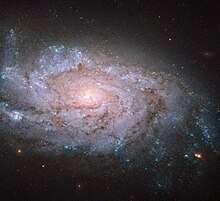
Cristina Chiappini in: The Formation and Evolution of the Milky Way,The California Institute of Technology
- The Milky Way is a spiral disk galaxy, similar to many others we see in the sky. This surprisingly beautiful shape is so common among galaxies that the universe almost seems to delight in building them. The end product is especially remarkable in the light of what is believed to be the starting point: nebulous blobs of gas.
- In: p. 1

- The gas blobs that evolved into the Milky Way consisted merely of hydrogen and helium (and a smattering of lithium), the elements that were created in the Big Bang. All the other elements were literally created by the stars. Unlike the medieval alchemists, the stars can actually transmute one element into another—they are prodigious chemical factories. Nevertheless, even today hydrogen and helium make up about 98 percent of the normal matter in the universe. It’s the distribution of the elements that make up the final 2 percent that makes all the difference to studies of galactic evolution.
- In: p. 1
- Although the development of new technologies has improved the quality of the observations and so refined the constraints on astronomers’ models, we are still far from a complete understanding of our galaxy’s evolution. Like our galaxy, the field itself is still evolving.
- In: p. 1
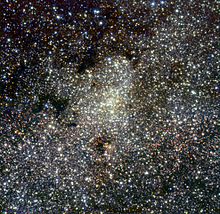


- As we arbitrarily divide the human body into a torso with a head and limbs, so we can conceptually separate the Galaxy into various components. The flying-saucer shape—consisting of the central bulge and the spiral disk—is only the most obvious part of the Galaxy. The spiral disk itself can be subdivided into a thin disk, which rises about 1,000 light-years above and below the galactic mid-plane, and a thick disk, which extends to about 3,500 light-years on either side of the plane. The relative flatness of our galaxy is evident when one considers that the galactic disk is generally thought to be about 120,000 light-years across. Our sun resides in the thin disk about 28,000 light-years from the galactic center... About 200 globular clusters are known, and they appear to be some of the oldest objects in the Galaxy. It took many decades of careful study to tease apart the various regions of the Milky Way, and the process of dissecting out fine-scale subregions continues even today.One of the reasons it’s so difficult is that we cannot measure the properties of all the stars in the Galaxy—they are simply too far away....the different orbits of the stars, their kinematic properties, provide a crucial distinction between stars that belong to different regions of the Galaxy
- In: p. 2
- A star’s kinematic properties are one of the ways that astronomers can recognize an interloper from another part of the Galaxy. ...The most metal-poor star ever observed in our galaxy is located in the halo. It is old and has a metallicity [Fe/H] of about -4.0, or about 10,000 times less than the Sun!
- In: p. 3
- There is another type of exploding supernova that also seeds the Galaxy with elements. This is the type Iasupernova. This explosion involves a binary system in which a white dwarf star and an intermediate-mass star (a red giant) orbit each other. The two stars are so close to each other that the white dwarf gradually pulls a considerable amount of material from the outer envelope of the expanding red giant. At a certain point the white dwarf will acquire so much mass that it collapses under its own weight and produces an explosion that blasts the bulk of its material into the interstellar medium—mostly in the form of iron, but also some sulfur, silicon and calcium. Such explosions contributed about 70 percent of the iron we see today in the Galaxy....three processes hold an important key to understanding the evolution of the Milky Way precisely because they occur on very different timescales. By measuring specific abundance ratios in stars from different parts of the Galaxy, astronomers can discover how fast the metal enrichment proceeded and the timescale over which the region was formed.
- In: p. 4
- The granddaddy of galactic-formation models was conceived in the early 1960s by three astronomers: Olin Eggen, Donald Lynden-Bell and Allan Sandage. Their 1962 publication played a seminal role in the field and is now simply referred to by the authors’ initials: ELS....According to ELS, the Milky Way began as a spherical cloud of gas—a protogalaxy—that was born collapsing toward its center.The original gas was poor in metals, and so stars formed as the cloud was collapsing would also be metal poor.These newly made stars maintained the kinematic properties of the gas in the collapsing cloud, and so followed eccentric orbits around the center of the Galaxy, forming the population II stars of the halo and the globular clusters. As the cloud contracted, some of its energy would have been lost to heat in a dissipative collapse;
- In: P.6,7
- In the decades that followed, a number of observations indicated that the Galaxy could not have formed in such a rapid collapse. The ELS model, as originally proposed,could not be right. One notable alternative was suggested by the American astronomers Leonard Searle and Robert Zinn in 1978… Instead of a single-cloud collapse, Searle and Zinn proposed that the halo of the Milky Way formed by the aggregation of many cloud fragments, each of which may have already formed stars and globular clusters
- In: p. 7
- More observations are needed before we can refine our models of the Milky Way’s evolution. For one thing, we are still uncertain about the formation timescale For the thin disk outside the [[w:Local Interstellar Cloud}solar neighborhood]] because we lack precise observational constraint.
- In: p. 12
- The GAIA project, which [was] slated to be launched by the European Space Agency by 2012, holds great promise for our attempts to solve the puzzle of the Milky Way’s formation. The GAIA satellite will be taking a massive stellar census, measuring the positions, motions and chemical compositions of more than a billion stars. It will, in effect, provide a three-dimensional map of our galaxy with unprecedented accuracy and resolution.
- In: p. 13

